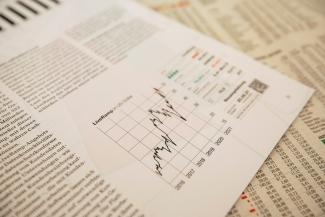
Looking for Yield in all the Wrong Places
These days, the most often posed client question I field is, “Why there is so much cash in my account earning 0% interest?”
At this time, I have north of $50 million in cash in client accounts, most of which has accumulated from bonds (including CDs) that have matured and have not been reinvested. My response is typically blunt and unambiguous – “Because bonds (and bond mutual funds) are no longer a viable asset class for consumers. In terms of liquid securities, consumers now have just two asset classes – Stocks and cash.”
Interest rates today remain near historic lows. So low, in fact, that there is almost no reward for tying up money in bonds or CDs with maturities in the 1-5 year range. While nominally higher yields can be obtained by extending maturities further (the 10-year treasury yield has recently risen above 2.5%), in my judgment, the principal risk to investors if interest rates continue to rise is not worth the meager short-term improvement in yield.
The frustratingly low yield has led some investors to open their ears to the Siren song of certain large financial institutions pitching “Equity Linked Notes.” These sexy-sounding instruments promise investors a reasonably attractive fixed return that is tied to the performance of a market index and will even pay if the index declines…a little bit. The problem with these packaged derivative securities – aside from tax complexity - is that they will pay (or at least repay principal) under normal market conditions, but your principal is at risk if the index experiences significant downside (i.e., when you need the stability of fixed-income investments in your portfolio the most!).
IMO, ELNs are a sterling example of how clever Wall Street investment firms create synthetic securities that serve as an additional profit center. My sense is that most consumers are attracted to ELN yields without fully understanding the risk.
Sidebar: Many FPH clients have also been inquiring about the wisdom of reallocating accumulated cash to rising dividend stocks. Yes, 2-3% dividends from healthy companies with established records of raising their dividends at a rate that exceeds inflation are relatively common. I understand the attraction, but the comparison of bond/cd yields to stock dividends is apples to oranges. Rising dividend stocks are still stocks. Company specific issues and/or market declines can easily sink any stock 30% or more in a short period of time. That will not happen with FDIC insured cash. The risk/volatility profiles of the two asset classes are very different.
Related Reading:
Why Structured Notes Might Not Be Right for You (Investopedia)
A 13% Yield: What Could Go Wrong? (Morningstar)
John H. Robinson is the founder of Financial Planning Hawaii and a co-founder of software maker, Nest Egg Guru
DISCLOSURES
Securities offered through J.W. Cole Financial, Inc. (JWC) member FINRA/SIPC. Advisory services offered through Financial Planning Hawaii and J.W. Cole Advisors, Inc. (JWCA). Financial Planning Hawaii and JWC/JWCA are unaffiliated entities.
Fee-only financial planning services are provided through Financial Planning Hawaii, Inc, a separate Registered Investment Advisory firm. Financial Planning Hawaii does not take custody of client assets nor do its advisers take discretionary authority over client accounts.
The information contained herein is general in nature. Neither Financial Planning Hawaii nor J.W. Cole provides client-specific tax or legal advice. All readers should consult with their tax and/or legal advisors for such guidance in advance of making investment or financial planning decisions with tax or legal implications.

